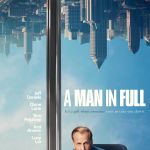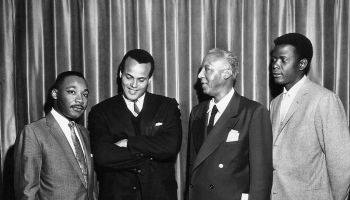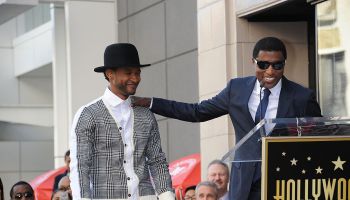Cey Adams is many things but what he’s known for is his work with Def Jam Records. A graffiti artist turned painter turned graphic designer, Adams may be credited as the seminal iconographer responsible for the typographic and layered visual history of hip-hop. He is also the graphic designer of Def Jam: The First 25 Years of The Last Great Record Label, a long overdue book about the first 25 years of Def Jam. (The book, published by Rizzoli is in stores on October 11 and can be pre-ordered online now.)
GlobalGrind spoke to Cey about his legacy and his upcoming book. Here’s what went down.
GlobalGrind: How did you make the jump from graffiti artist and painter to working with Def Jam?
Cey Adams: It was a quick, and also a really slow process. I met Russell (Simmons) around 1983 and at the time he had Rush Productions. He was managing Kurtis Blow, Run DMC and a few other local rappers. I was recommended to him by a photographer who was shooting the cover for Run DMC’s album at the time. I went in and talked to Russell and he put me to work designing flyers and piece sets for bands that were going on tour. I hit the ground running. A few years later, Rick (Rubin) and Russ started Def Jam and they asked me if I knew how to design album covers and I said ‘no.’ They said, ‘you have to learn’ and that was it. I mean, they just really put me to work and I had to figure it out.
Did you design the Def Jam logo?
No. Surprisingly enough, it’s one of the things along with the Run DMC logo that I do, unfortunately, get credit for. The Def Jam logo was designed by Rick Rubin. Very few people know that, but it was.
What was your first album cover?
The first album cover I did was Oran “Juice” Jones’ because, prior to that, the folks up at CBS and Columbia were designing most of the early album covers. I was just busy out on tour, traveling and doing everything else. Also, I don’t know how much faith they had in me at the time. It wasn’t until I really asserted myself, got an opportunity and really kind of ran with it.
You’re responsible for a lot of the looks and iconography that originated in early Hip-Hop, how does that feel?
I honestly don’t think about it that much because it was just such a great time together with all the artists as we were all kind of coming out together. It’s like high school: you look back on high school with fond memories [Laughs]. Def Jam and Rush was kind of like a finishing school, similar to the old days. I got a lot of experience in a very short amount of time. There wasn’t a lot of pressure because we were all trying to figure it out at the same time. It was a great thing and I’m really proud of all that.
How did you approach designing the book and what was your response when Bill Adler asked you to come aboard?
When Bill approached me, I couldn’t imagine anybody else doing it because, like Bill, I have a photographic memory when it comes to the history of Def Jam and all its artists. I’ve been one, consistent over the years when it comes to all the different components with how the images are crafted by all these artists. And certainly my partner Steve Carr included (I can’t forget him); the two of us were really instrumental in shaping the look and feel of the label as it relates to all the individual artists.
For me it was no simple task because I knew what was at stake. First and foremost, Def Jam is the most important Hip-Hop label of all time, and it’s one of the most important record labels of all time. It was a big, big opportunity and I couldn’t imagine anybody else doing it because over the years I found out that very few people are familiar with the complete history of the label. I knew I wanted the work to speak for itself and I knew that I wanted the images to really breathe. I didn’t want it to be over designed. This wasn’t an opportunity for some new jack to really catch his design chops, showing all the different tricks that he can do in layout! [Laughs] I really fought to make sure that all the images were as large as possible. I kept the designs to a minimum, and I really designed 3 separate books before I was happy with what I came up with. I knew that I wanted the typography to be clean and easy to read but, first and foremost, I wanted those images to really jump off the page.
[pagebreak]
When designing the book you came across images which you hadn’t seen for almost 30 years. What was happening to you? Were you flooded with memories, were you recalling events, places and things?
Most certainly! One of the best things about doing this book and knowing Rick, Russell and Lyor, and Kevin Liles and Bill Adler is that they really trust my vision. They all know my history with the label, so I didn’t have a lot of people getting in the way. Me and Bill Adler just basically sat down and decided how we wanted to flesh out the book. I personally went to a lot of my own archives as well as Bill Adler’s so it wasn’t a situation where I hadn’t seen some of the images in a long time. I knew exactly where to look; I just opened up my files. It’s very emotional, it’s like trying to edit your wardrobe closet, and it’s very difficult. These images are very personal to me and I fought with myself to make sure that I not only used the Def images but the images by the most important photographers that were working at that time.
[pagebreak]
Is there a particular image, series of images, or sections of the book that you’re fond of?
Oh, sure! I’m very fond of the early years and that’s because that was a time when photographers were shooting music and these artists because they really loved them. Nobody was getting paid to do this; it was a real labor of love. Knowing that you can put your hands on some of those really early gems from the late 70s and early 80s is a big deal. A lot of those photographers are no longer working, negatives have gotten lost and so, thanks to the Adler Archives, we were lucky enough to be able to put our hands on exactly which images and materials we needed for the book. I have to tell you that it’s to our credit that we’ve held on to this material. This content would be impossible to find if you didn’t know where to look, and it was all in one or two locations.
How long did it take getting this book out?
You know, it’s funny. Bill and I worked on it for maybe about 2 years but certainly it was much longer than that when you think about the fact we toyed with the idea of doing this for the 10th anniversary. We re-visited it on the 15th anniversary and so finally we got an opportunity to do it for the 25th anniversary and the reality is, it’s really the 27th anniversary. We’ve been thinking about this project for a very long time and so when I think back to your question about how I felt getting the opportunity to design this book, I just could not imagine anybody else doing it!
[pagebreak]
One of your accomplishments include designing the Hip-Hop Wing of the Rock & Roll Museum. What was that experience like for you?
Wow, it’s funny you should mention that because I ended up working on that simultaneously while I was working on this book. It was a great thing because for me, being able to still do the work that is related to this music and this label is a huge honor. I don’t take it lightly at all, and I think it is important for young people to kind of understand that I didn’t just get here yesterday. I put in a lot of years paving the way for everybody that is sitting in front of a laptop, in a coffee shop, calling themselves graphic designers. When I worked on that, just being affiliated with the Grammy Museum was just a great honor because it’s been such a long time between us getting recognized by these official academies.
I also did an exhibition with MOMA, the Museum of Modern Art, and it was the same thing, them finally recognizing that hip-hop is an important art form and the people behind the scenes are equally as important as the artist in front of the scene. It’s something that feels good and it’s really a long time coming.
[pagebreak]
When you look back on you career are you surprised by your its trajectory?
No, no, really! I try not to look back too much because there is so much stuff moving quickly in front of me and I spend a lot of my time trying to pay attention to what’s happening today but it’s nice to be able to look back with an anthology like this book and say, OK, this is not only the history and career of LL Cool J, Public Enemy and the Beastie Boys, it’s also my history. It was a great opportunity to insert some images and memorabilia of myself, Steve Carr and some of the folks behind the scenes that don’t normally get credit. It’s a lot of fun to still be around and still be doing work that’s relevant but knowing that we have this rich history that people are finally starting to pay attention to.
Helvetica was identified as the font of the 20th and 21st Century. Is there a particular font that can be associated with hip-hop?
It would be Helvetica because even early on, I knew I wanted the work that Steve and I were doing to be timeless. I learned that the only way to do that is to stick to a font that would stand the test of time. So in the 80s, Helvetica was a classic font; I decided right from the start that I was going to adopt that. Granted I used a lot more Helvetica Bold, and Helvetica Condensed a lot more than I do today.
What projects do have coming up that you would like to promote?
Well, right now I’m just finishing up a 3 panel series of canvases centered around the 10th Anniversary of 9/11 and the red, white and blue is hanging around the Green Space down at 160 Varick Street, which was the same exact building that Def Jam was in. All readers go down to the Jerome L Greene Space down on Varick and Houston! You can see the most recent piece that I’ve created in the space. Working on that painting in that space was very emotional for me because I spent so many years designing album covers upstairs. It’s almost like a weird sort of homecoming and it’s just a few stops from Ground Zero. It really kind of sums up my history with Def Jam and Lower Manhattan and New York in general. It’s really nice to be able to do work that resonates over a long period of time, and I hope to be doing that for a lot more years to come.
















